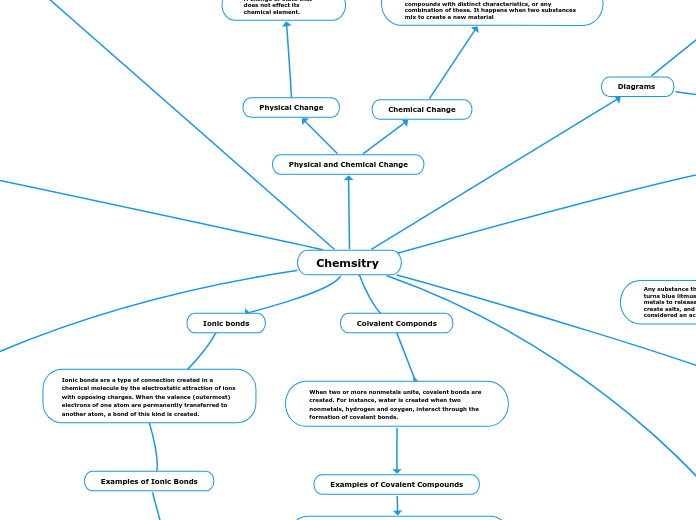Chemsitry
Basic Definitions
Valence Electrons
An electron that lives in an atom's last electron shell, also known as the valence shell, is known as a valence electron. Depending on how many electrons the atom possesses, it will either have one or many electron shells. The valence electrons are located in the atom's final shell.
Electrons
Neutrons
Every atom's nucleus has a neutron, with the exception of plain hydrogen, which does not. The fact that the particle has no electrical charge—it is neutral—gives it its name. Neutrons have a very high density.
Protons
Every atom has a proton, a subatomic particle, in its nucleus. The particle possesses an electrical charge that is positive and opposite to the electron's.
Atoms
A chemical element is uniquely defined by its atoms, which are tiny pieces of substance. An atom is made up of a core nucleus and one or more negatively charged electrons that orbit it.
Matter
Matter is anything that can be weighed
or that can take up space
Diagrams
Bohr-Rutherford Diagram
Bohr-Rutherford diagram are simple atomic
models that show the number of electrons in each shell.
Lewis dot Diagram
A Lewis dot diagram represents the valence
electrons of an atom by drawing the dots around the symbol of the element.
Physical and Chemical Change
Physical Change
A change of state that does not effect its chemical element.
Examples of Physical Change
Chemical Change
A chemical change is the transformation of one substance into another, the emergence of new compounds with distinct characteristics, or any combination of these. It happens when two substances mix to create a new material
Examples of Chemical Change
Periodic Table
Chemical Properties
An attribute of a specific material that may be seen in a chemical reaction is called a chemical property. Major chemical characteristics include chemical stability, flammability, toxicity, heat of combustion, pH value, and rates of radioactive decay.
Physical Properties
Physical properties are characteristics of matter that can be seen and quantified without altering a sample's chemical composition. The arrangement of the material in a sample may change when a physical attribute is measured, but the molecules' structures are unaffected.
Chemical Reactions
Types of chemical reaction
Double displacement
when two ionic compounds' components are switched, creating two new compounds.
Example of Double displacement
Combustion
Incomplete
Its like a complete but a imcomplete reaction happens when there is not enough oxygen gas
Example of Incomplete Combustion
Complete
processes of combustion occur whenever a hydrocarbon interacts with oxygen gas. This process can be refered to burning.
Example of Complete Combustion
Decomposition
A Decompositon reaction is when 1 element
breaks up into 2 or more elements
Example of Decomposition
Synthesis
When two or more reactants unite to create a single product, this is known as a synthesis reaction.
Example of Synthesis
Equations
Examples
Balanced
A BALANCED CHEMICAL EQUATION describes chemical
change using the chemical formulae as well as balancing
coefficients that show you the amount of each substance.
Skeletal
The basic representation of a chemical reaction is a skeleton equation. The chemical formulae are listed, with a plus sign between each one.
Word
A word equation in chemistry is the expression of a chemical reaction in words as opposed to technical formulae. The reactants (initial materials), products (outcomes), and direction of the reaction should be stated in a word equation in a way that might be converted into a chemical equation.
Product
The atoms and molecules created during a chemical reaction are referred to as products. Only atoms from the reactants can end up in the products of a chemical reaction. No atoms are destroyed or made into new ones.
Reactants
Reactants are the chemicals that take part in a chemical reaction. The process through which atoms, the fundamental constituents of matter, rearrange themselves to create novel combinations is known as a chemical reaction. Raw materials are reactants because they interact with one another.
Acids and Bases
pH table
Bases
A base is a chemical that reacts with hydrogen ions to neutralise the acid. The majority of bases are mineral compounds that combine with acids to create water and salts. The oxides, hydroxides, and carbonates of metals are examples of bases.
Acids
Any substance that tastes unpleasant in water solution, turns blue litmus paper red, interacts with certain metals to release hydrogen, combines with bases to create salts, and stimulates chemical processes is considered an acid.
Colvalent Componds
When two or more nonmetals unite, covalent bonds are created. For instance, water is created when two nonmetals, hydrogen and oxygen, interact through the formation of covalent bonds.
Examples of Covalent Compounds
Ionic bonds
Ionic bonds are a type of connection created in a chemical molecule by the electrostatic attraction of ions with opposing charges. When the valence (outermost) electrons of one atom are permanently transferred to another atom, a bond of this kind is created.
Examples of Ionic Bonds

